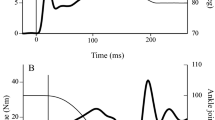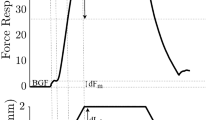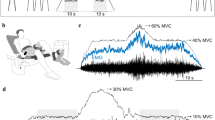Summary
The purpose of this study was to examine the effect of ankle position on the human ankle stretch reflexes during tonically-maintained contractions over most of the range of motion. The ankle was placed at randomly selected mean positions. Target levels of triceps surae (TS) or tibialis anterior (TA) tonic contractions were generated while the ankle was displaced by small amplitude, stochastic perturbations. System identification techniques were used to identify the stretch reflex dynamics at each combination of tonic level and ankle angle. As shown previously, the TS stretch reflex was characterized by an unidirectional, velocity-sensitive impulse response function whereas the TA stretch reflex was characterized by a linear impulse response function between ankle velocity and TA EMG. TS stretch reflexes showed a strong dependence on ankle position while TA stretch reflexes did not. Thus the TS stretch reflex magnitude increased greatly as the ankle was progressively dorsiflexed. In contrast, ankle mean position had only a minor effect on the TA stretch reflex magnitude. Our results indicate that the position-dependent facilitation of the TS stretch reflex is not due to changes in the level of skeletal motoneuron excitability. Rather, this effect may be accounted for by mechanisms that modulate the efficacy of the stochastic ankle perturbation. Such mechanisms could include position-induced: (1) modulation of monosynaptic and polysynaptic afferent inputs to skeletal motoneurons, (2) alterations in the extent of fusimotor drive and (3) changes in the transmission of the joint perturbation to spindle receptors. Such mechanisms are discussed in terms of the differences between TS and TA stretch reflexes. Finally, the functional significance of position-dependent reflex responses are considered.
Similar content being viewed by others
References
Appelberg B, Hulliger M, Johansson H, Sojka P (1983) Actions on γ-motoneurons elicited by electrical stimulation of group III muscle afferent fibers in the hind limb of the cat. J Physiol (Lond) 335: 275–292
Belanger AY, McComas AJ, Elder GBC (1983) Physiological properties of two antagonistic human muscle groups. Eur J Appl Physiol 51: 381–393
Boone DC, Azen SP (1979) Normal range of motion of joints in male subjects. J Bone Joint Surg 61-A: 756–759
Boussenna M, Corlett EN, Pheasant ST (1982) The relation between discomfort and postural loading at the joints. Ergonomics 25: 315–322
Burke D (1981) The activity of human muscle spindle endings in normal motor behaviour. Int Rev Physiol 25: 91–126
Burke D (1983) Critical examination of the case for or against fusimotor involvement in disorders of muscle tone. Adv Neurol 39: 133–150
Burke D, Andrews C, Ashby P (1971) Autogenic effects of static muscle stretch in spastic man. Arch Neurol 25: 367–372
Burke D, Hagbarth K-E, Lofstedt L, Wallin BG (1976) The responses of human muscle spindle endings to vibration during isometric contraction. J Physiol (Lond) 261: 695–711
Burke D, Hagbarth K-E, Lofstedt L (1978) Muscle spindle responses in man to changes in load during accurate position maintenance. J Physiol (Lond) 276: 159–164
Burke D, Gandevia SC, McKeon B (1984) Monosynaptic and oligosynaptic contributions to human ankle jerk and H-reflex. J Neurophysiol 52: 435–448
Delwaide PJ (1973) Human monosynaptic reflexes and presynaptic inhibition. In: Desmedt JE (ed) New developments in electromyography and clinical neurophysiology. Karger, Basel 3: 508–522
Delwaide PJ, Hugon M (1969) H reflex depression by soleus sinusoidal stretching and facilitation by voluntary contraction. Experientia 25: 1152–1153
Devanandan MS, Eccles RM, Yokota T (1965) Muscle stretch and the presynaptic inhibition of the group Ia pathway to motoneurones. J Physiol (Lond) 179: 430–441
de Vries, HA (1968) Method for evaluation of muscle fatigue and endurance from electromyographic fatigue curves. Am J Phys Med 47:125–135
Gottlieb GL, Agarwal GC (1979) Response to sudden torques about the ankle: myotatic reflex. J Neurophysiol 42: 91–106
Hagbarth KE, Vallbo AB (1968) Discharge characteristics of human muscle afferents during muscle stretch and contraction. Exp Neurol 22: 674–694
Hellebrandt FA, Tepper RH, Braun GL, Elliott MC (1938) The location of the cardinal anatomical orientation planes passing through the center of weight in young adult women. Am J Physiol 121: 465–470
Hugon M (1973) Methodology of the Hoffman reflex in man. In: Desmedt JE (ed), New developments in electromyography and clinical neurophysiology. Karger, Basel 3: 277–293
Hulliger M, Nordh E, Vallbo AB (1982) The absence of position response in spindle afferent units from human finger muscles during accurate position holding. J Physiol (Lond) 322: 167–179
Hunter IW, Kearney RE (1983a) Invariance of ankle dynamic stiffness during fatiguing muscle contractions. J Biomech 16: 985–991
Hunter IW, Kearney RE (1983b) Two-sided linear filter identification. Med Biol Eng Comput 21: 203–209
Jankowska E, McCrea D, Mackel R (1981) Oligosynaptic excitation of motoneurons by impulses in group Ia muscle spindle afferents in the cat. J Physiol (Lond) 316: 411–425
Kearney RE, Hunter IW (1983) System identification of human triceps surae stretch reflex dynamics. Exp Brain Res 51: 117–127
Kearney RE, Hunter IW (1984) System identification of human stretch reflex dynamics: tibialis anterior. Exp Brain Res 56: 40–49
Mark RF, Coquery J-M, Paillard J (1968) Autogenic reflex effects of slow or steady stretch of the calf muscles in man. Exp Brain Res 6: 130–145
Marsh E, Sale D, McComas AJ, Quinlan J (1981) Influence of joint position on ankle dorsiflexion in humans. J Appl Physiol 51: 160–167
Paillard J (1960) Functional organization of afferent innervation of muscle studied in man by monosynaptic testing. Am J Physiol 199: 239–247
Prochazka A, Hulliger M (1983) Muscle afferent function and its significance for motor control mechanisms during voluntary movements in cat, monkey, and man. Adv Neurol 39: 93–132
Rack PMH, Ross HF, Thilmann AF, Walters DKW (1983) Reflex responses at the human ankle: the importance of tendon compliance. J Physiol (Lond) 344: 503–524
Rack PMH, Westbury DR (1984) Elastic properties of the cat soleus tendon and their functional importance. J Physiol (Lond) 347: 479–495
Sale D, Quinlan J, Marsh E, McComas AJ, Belanger AY (1982) Influence of joint position on ankle plantarflexion in humans. J Appl Physiol 52: 1636–1642
Smith JW (1957) The forces operating at the human ankle joint during standing. J Anat 91: 545–564
Vallbo AB (1974) Afferent discharge from human muscle spindles in non-contracting muscles. Steady state impulse frequency as a function of joint angle. Acta Physiol Scand 90: 303–318
Vallbo AB, Hulliger M, Nordh E (1981) Do spindle afferents monitor joint position in man? A study with active position holding. Brain Res 204: 209–213
Weiss PL, Hunter IW, Kearney RE (1984) Rigid polyurethane foam limb casts. Med Biol Eng Comput 22: 603–604
Weiss PL, Kearney RE, Hunter IW (1985) Position dependence of stretch reflexes at the human ankle. Soc Neurosci Abstr 11: 214
Weiss PL, Kearney RE, Hunter IW (1986a) The position dependence of ankle joint dynamics: passive mechanics. J Biomech (in press)
Weiss PL, Kearney RE, Hunter IW (1986b) The position dependence of ankle joint dynamics: active mechanics. J Biomech (in press)
Author information
Authors and Affiliations
Rights and permissions
About this article
Cite this article
Weiss, P.L., Kearney, R.E. & Hunter, I.W. Position dependence of stretch reflex dynamics at the human ankle. Exp Brain Res 63, 49–59 (1986). https://doi.org/10.1007/BF00235645
Received:
Accepted:
Issue Date:
DOI: https://doi.org/10.1007/BF00235645




